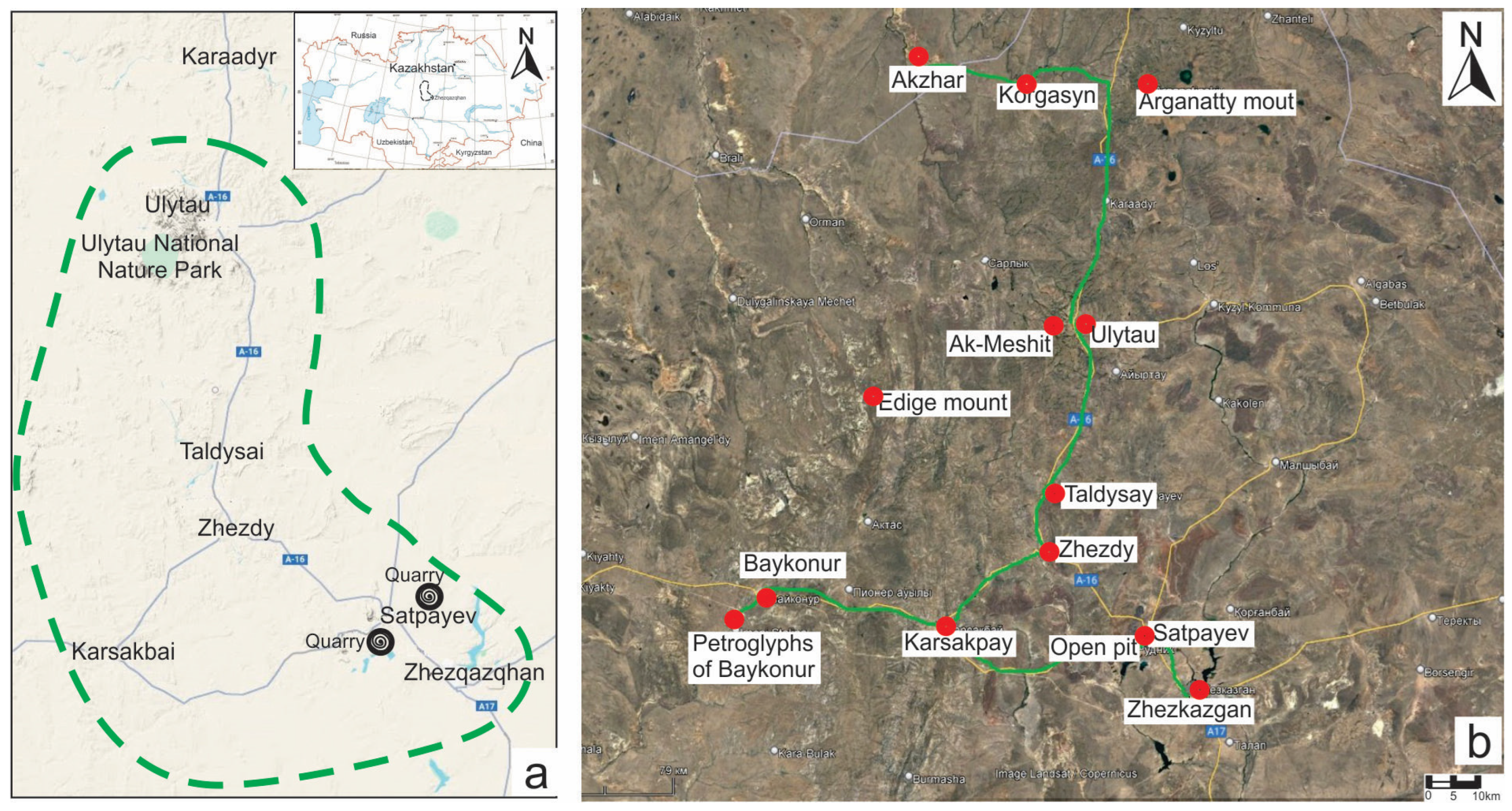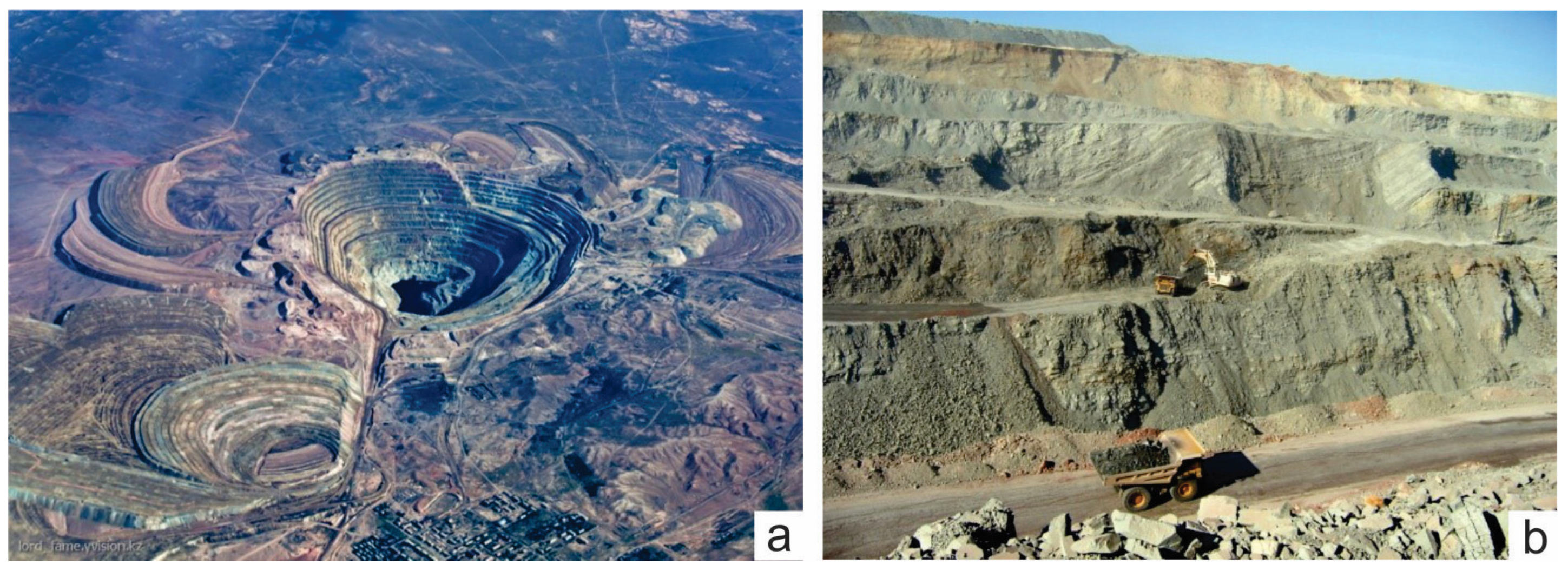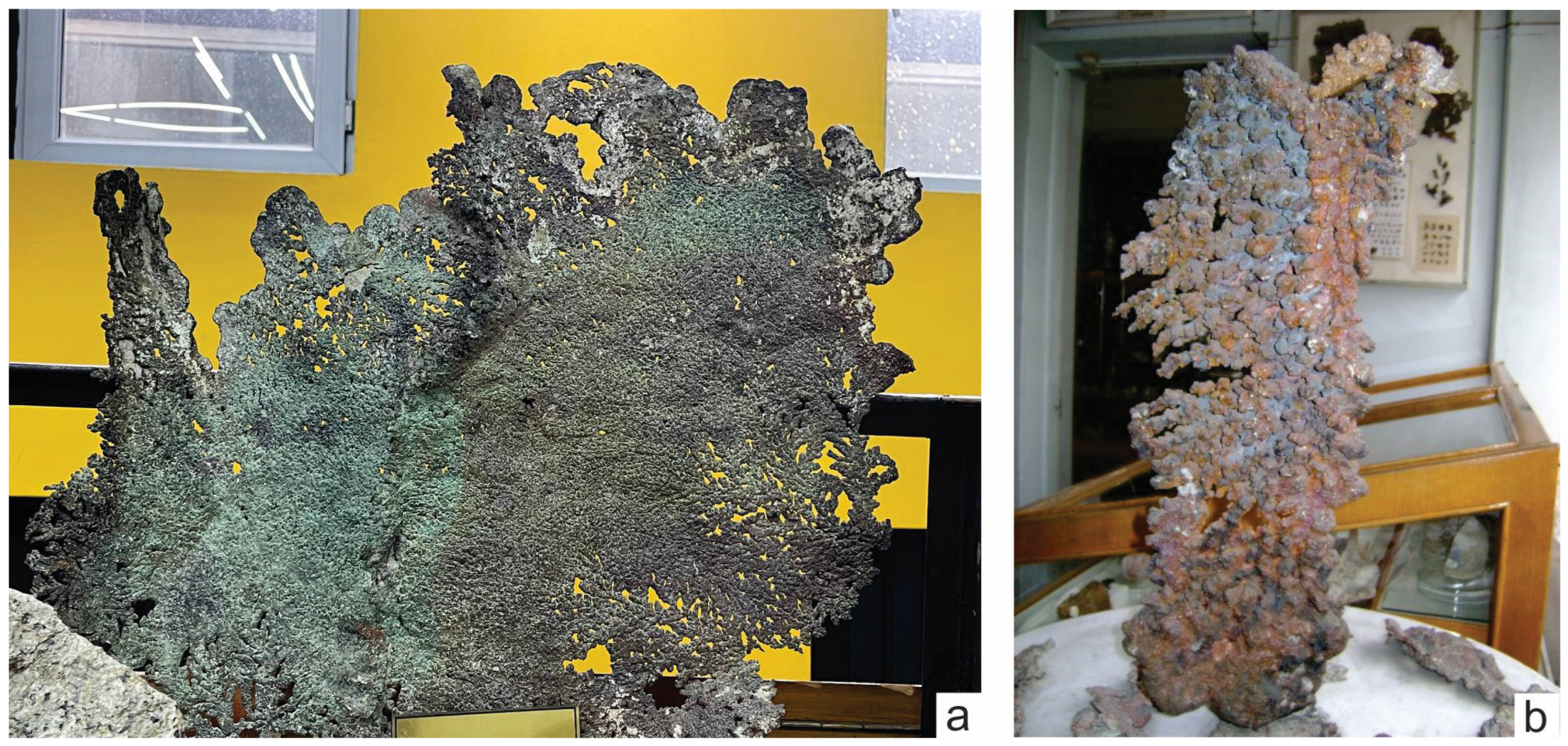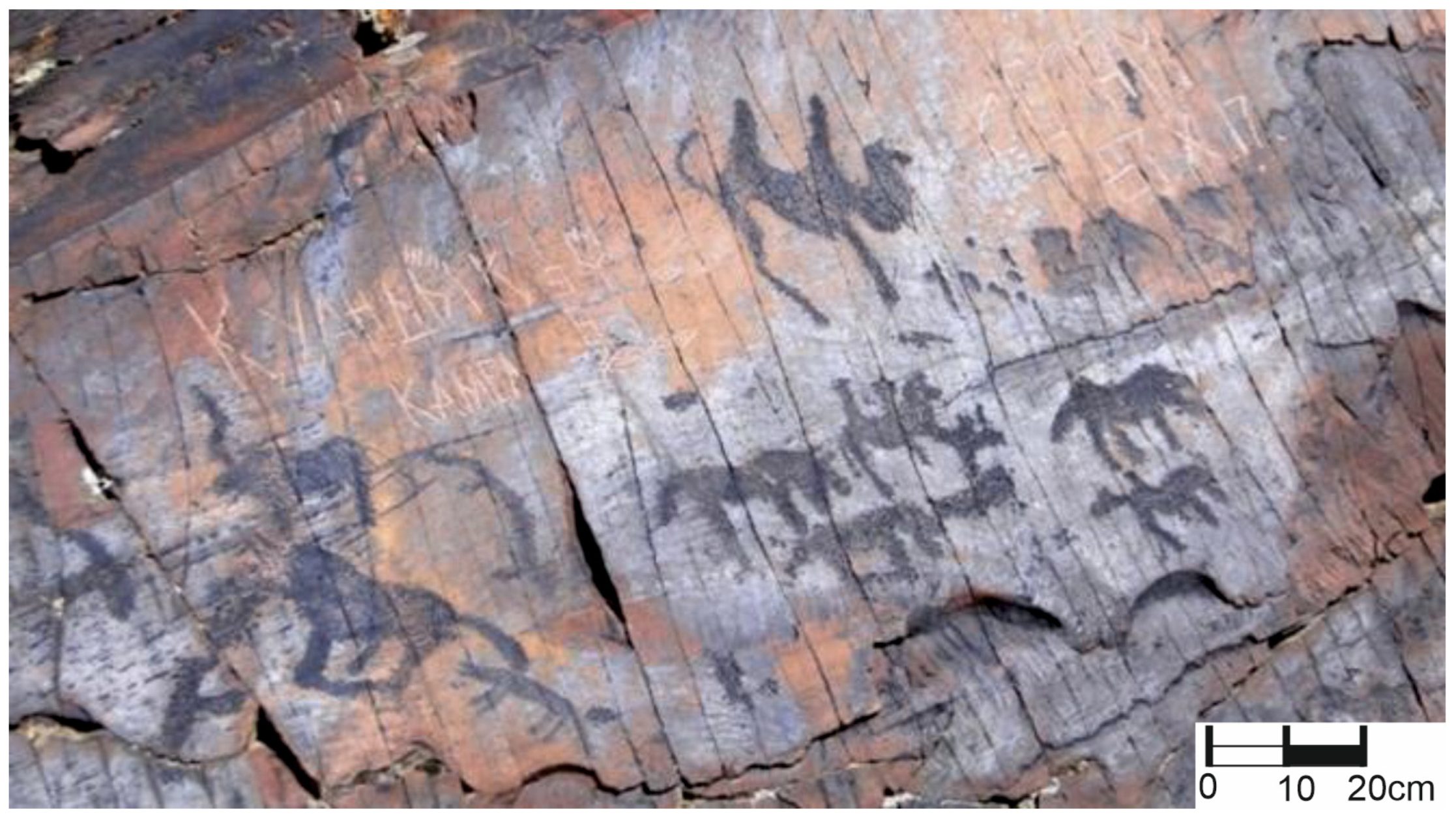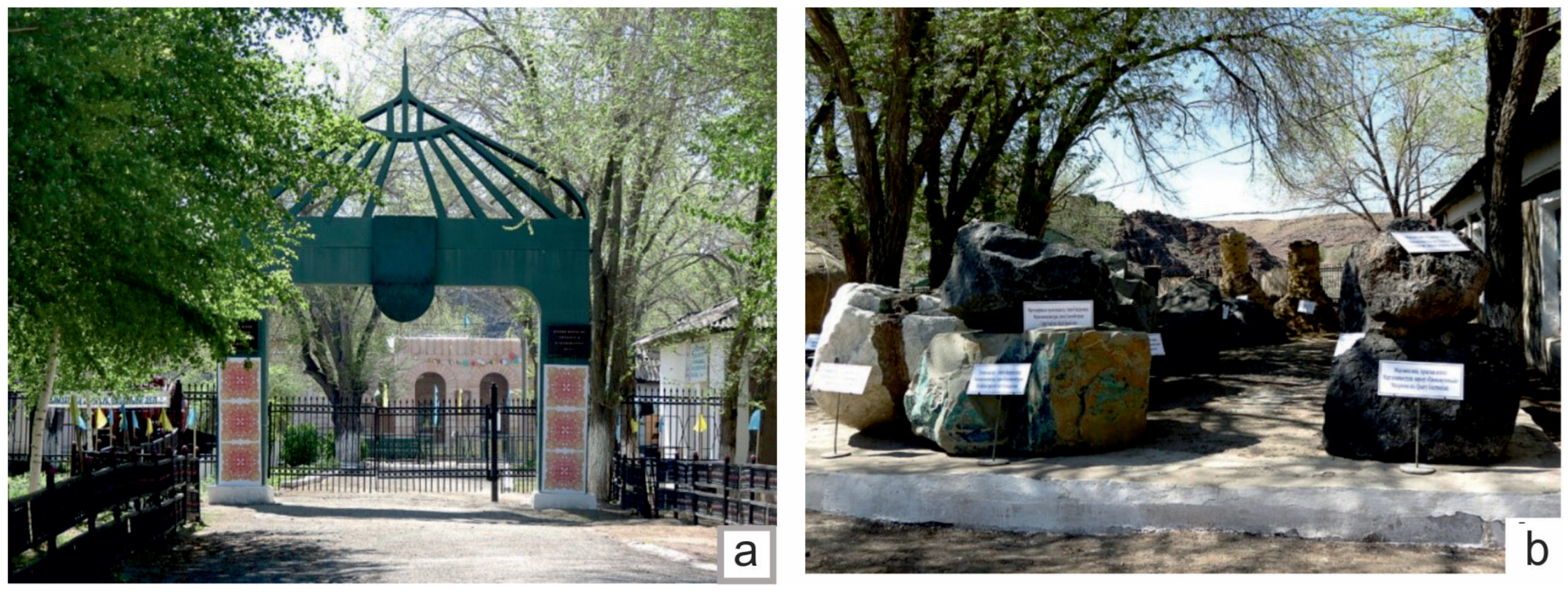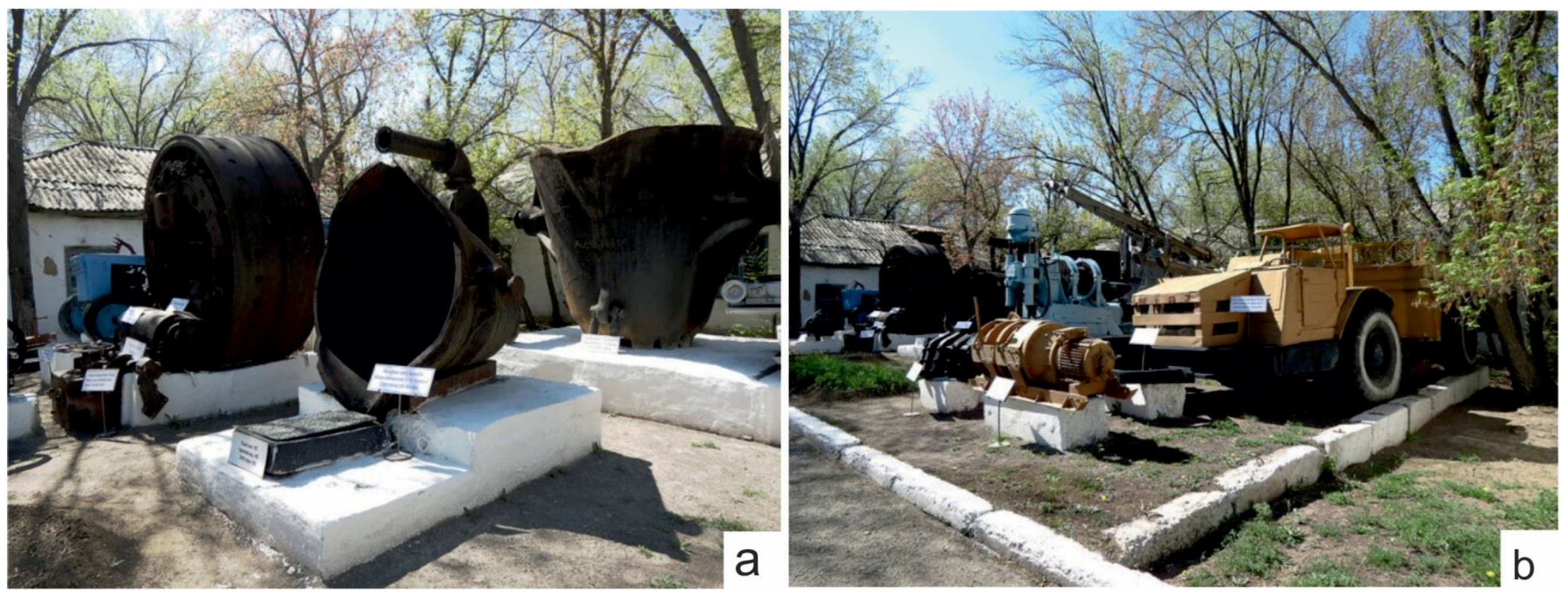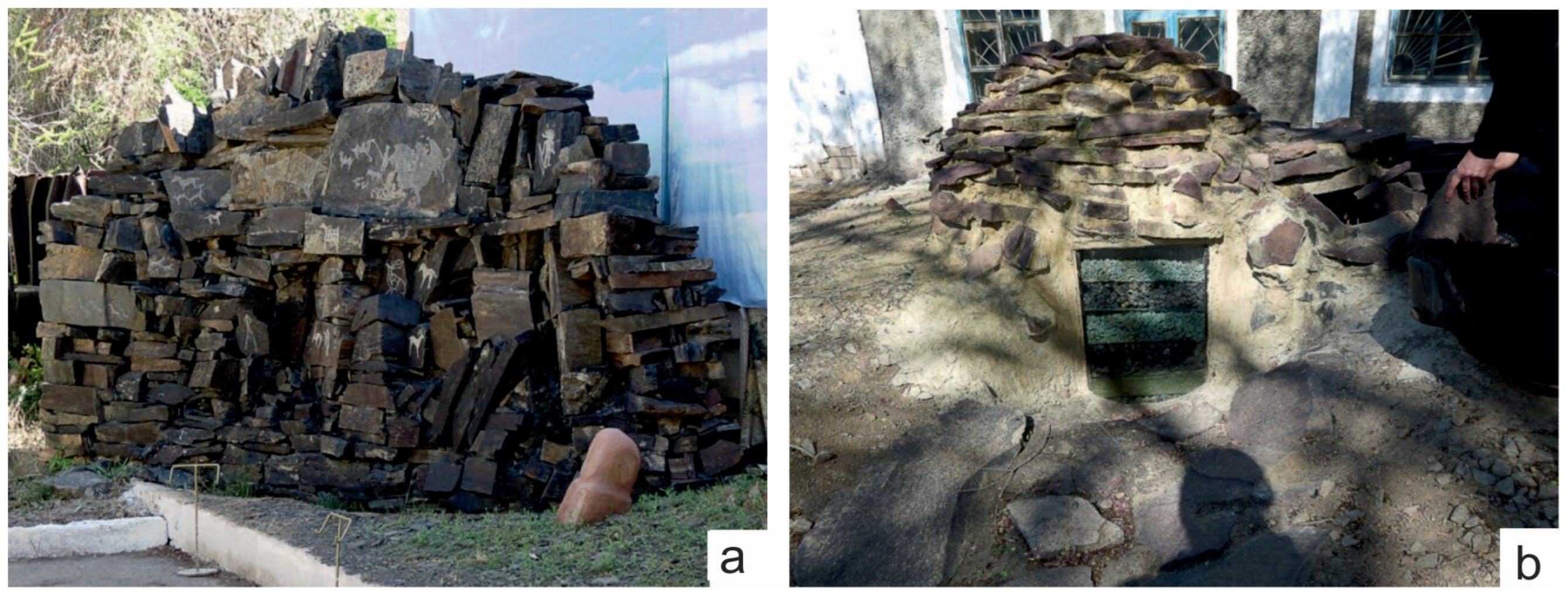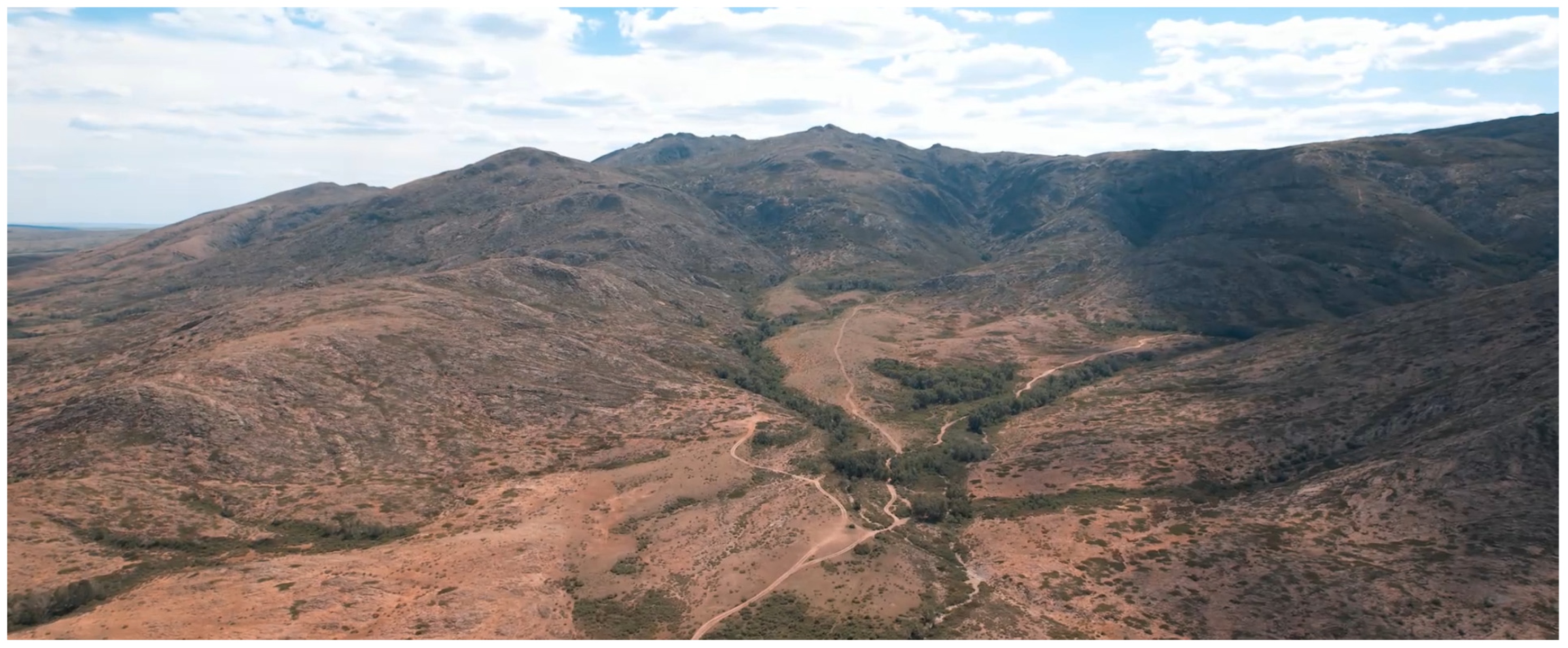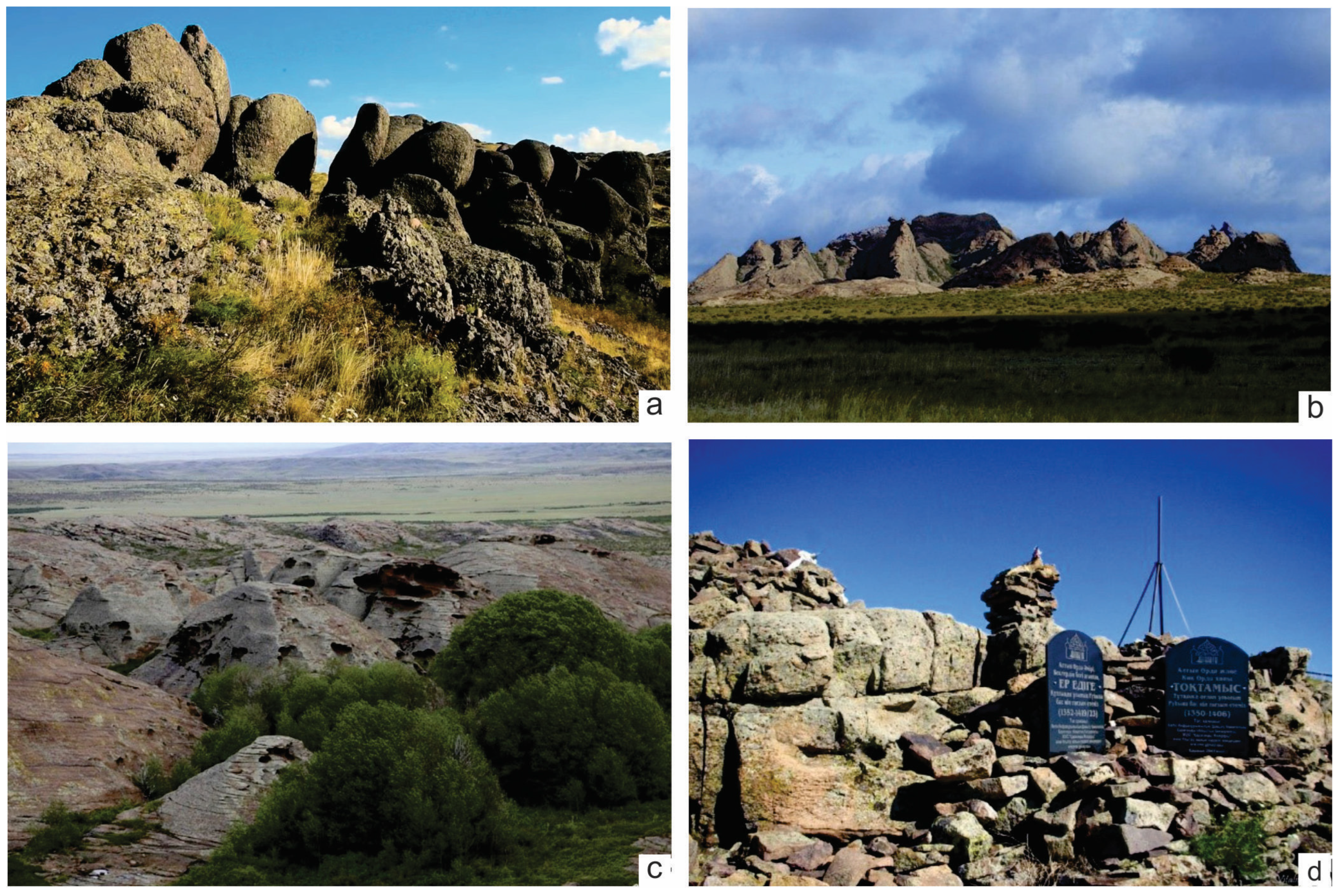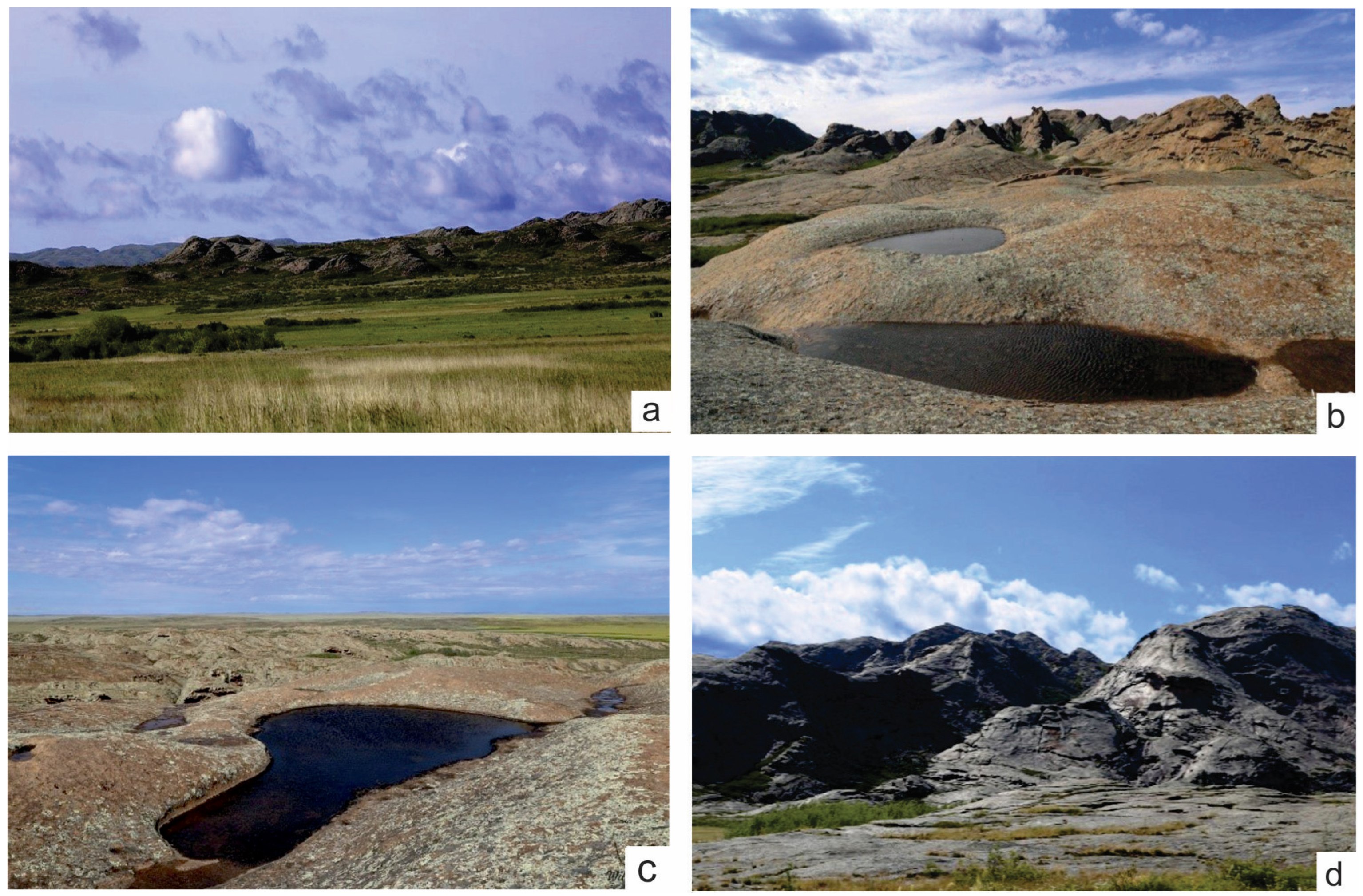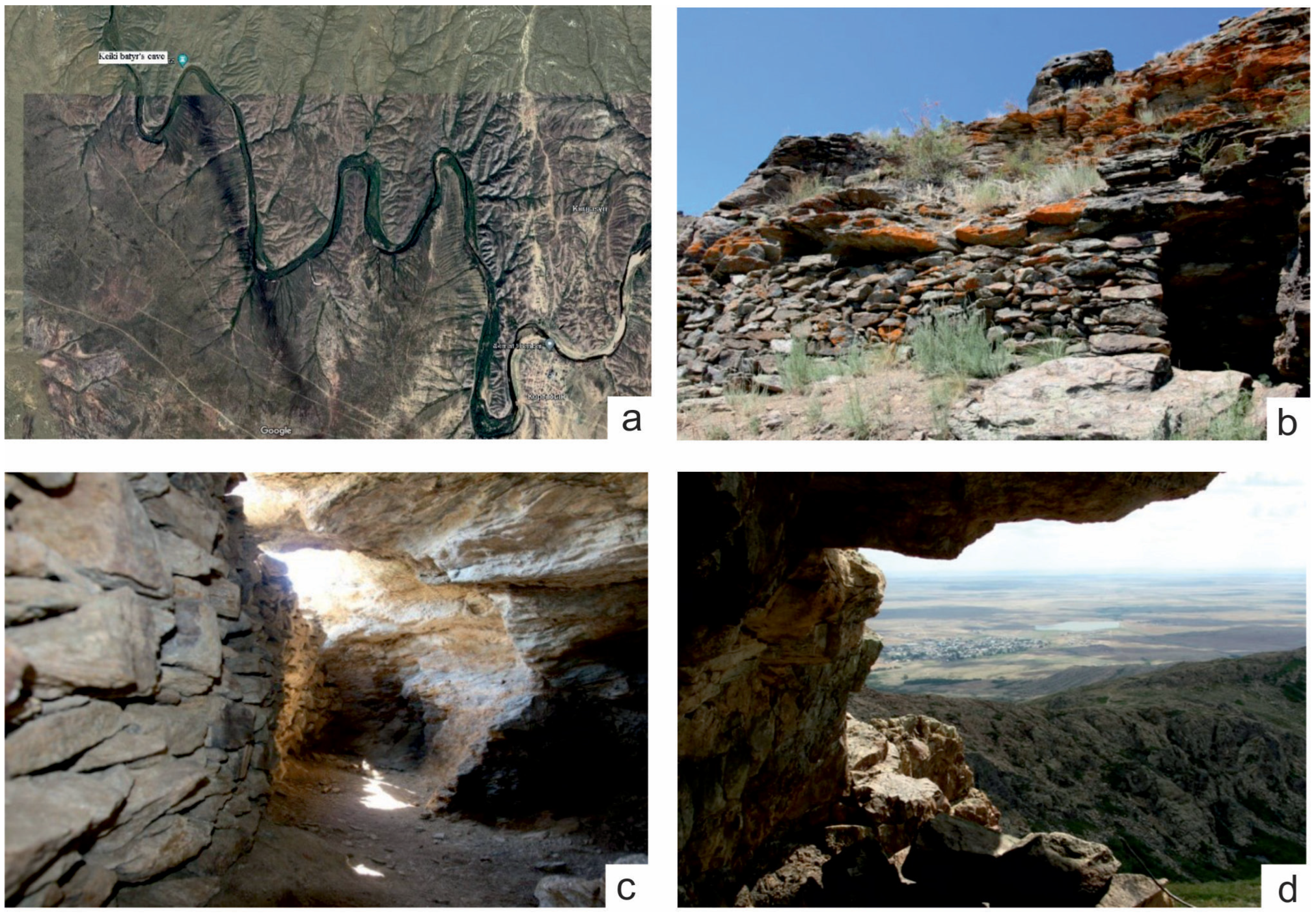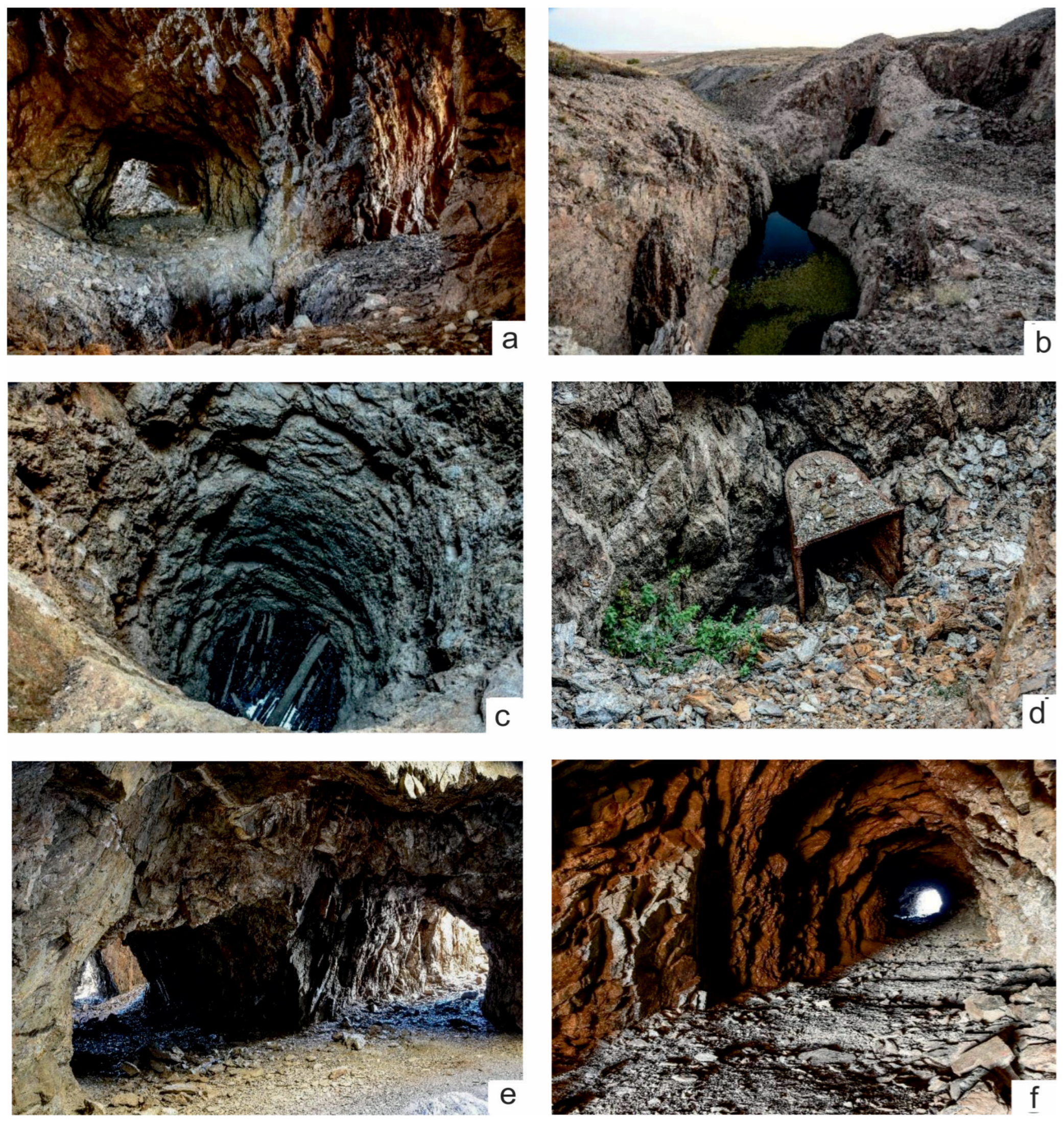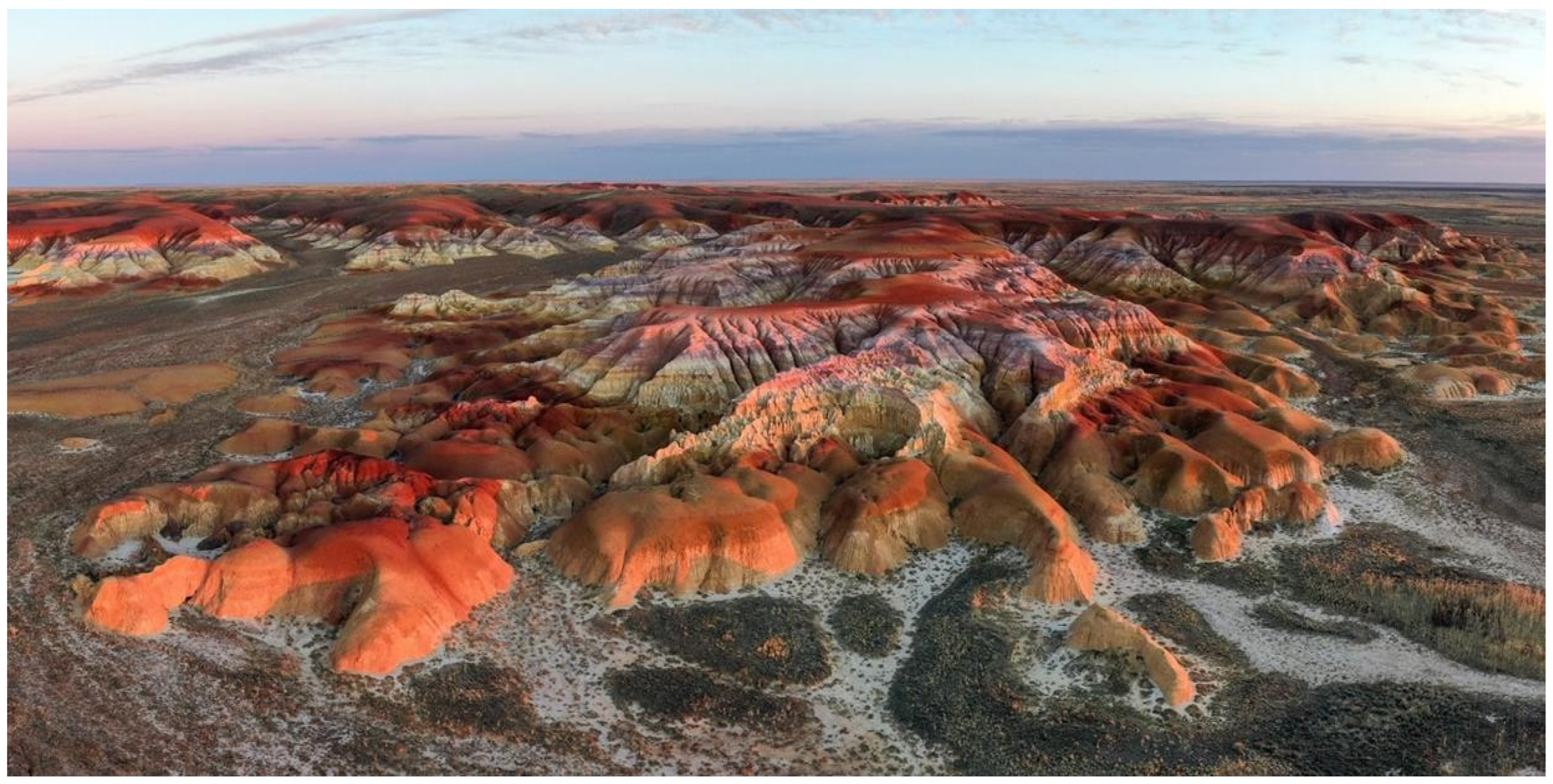3.1. Geomorphological Structure
The following landforms are identified on the territory:
Denudation plains and plateaus: structural (stratal) plains on horizontally lying rocks (300–500 m asl) and sculptural (basement) plains on a folded base.
There is denudation of small hills with predominant relief forms in the form of dome-shaped and conical hills and ridges, not exceeding 600 m asl, and relative elevations reach 200 m. Low ridges and ridge relief are less common. Ridges in the transverse profile are often asymmetrical; the ridges are characterised by levelled or slightly convex peaks with distinct slope edges. The steepness of the slopes of the ridges falls within the range of 15–40°.
Among the monotonous small hills, areas of low mountain ridges stand out sharply, with relics of ancient levelling surfaces and a clearly defined folded base. Against the background of denudation plains located at absolute levels of 500–600 m, the individual mountains stand out like Sea Islands: Ulutau (1133 m), Idygeh (1064 m), Airtau (850 m) and Zhaksy-Arganaty (757 m).
The rise of the Ulytau Mountains in the Pleistocene determines the stepped structure of their western slopes and the canyon-like type of valleys. The eastern slope of the Ulytau Upland is gentle, gradually turning into the arched rise of the Sarysu-Tengiz watershed. From the west, the hill is adjacent to the extensive structural and accumulative plains of the Turgai depression.
The Ulytau mountain range consists of low mountain ranges with an absolute height of 400–600 m above sea level, with individual sections reaching 800–1131 m (the highest peak of the massif is Mount Aulie). The second highest is Mount Edyge (1063 m high) and the third highest is Mount Koltau (925 m), located in the northern part of the mountains.
The mountain range stretches from southwest to northeast for more than 105 km; the greatest width in the central part reaches 27 km. The Ulytau massif is located in the Caledonian fold zone, surrounded by semi-deserts in the latitudinal zone.
The mountains are rugged and rocky to the ground. The main part of the mountain ranges is composed of collapsing granites and is so exposed to arid denudation that “in many places it appears as a mountainous rocky desert without any developed soil cover” [
28].
The ridge lowlands of Kyshtau and Zhaksy-Arganaty are composed of red Devonian sandstones and Precambrian shales. The absolute heights of the small hills vary from 200 to 600–700 m, and the relative elevations of ridges are 30–40 m. As with low mountains, small hills are characterised by the development of reliefs such as “kotyrtas” and “koitas” (sheep rocks).
To the east of the Ulutau Mountains and Zhaksy-Arganaty, the relief of conical hills is widespread. The highest peaked hills reach a height of 100–130 m. Near the river valleys, erosion–denudation small hills are developed. On the western slopes of the Ulutau Mountains and the southern slope of the interfluve of Ishim and Sarysu, a denudation plain is developed, fixed by weathering crust with a thickness of up to 10 m. The absolute elevations of the plain surface of 360–400 m gradually decrease to the west. Within hypsometric marks of 400–500 m above sea level, on the right bank of the Sarysu River and on the western and southeastern outskirts of the Ulutau Mountains, flat and slightly undulating plains are formed on horizontally lying Paleogene-Neogene deposits.
Accumulative plains of lacustrine–deluvial origin are widespread near the Sarysu River valley.
3.2. Geological Structure
Copper deposits in the Ulytau region belong to the Zhezkazgan type, with unique and high-quality copper reserves concentrated in nine ore-bearing horizons of medium thickness in a relatively compact area.
In Kazakhstan, more than 70% of copper deposits are stratiform, the host rocks of which are sediment-hosted, with significant differences in size, reserves and mineral associations.
The Zhezkazgan ore field is located at the junction of the meridional folds of the Ulytau zone, with the latitudinally extending block-fold structures of the Sarysu-Teniz uplift. At their junction, brachyanticlines, domes and troughs are developed, which were named by Yu. A. Zaitsev [
27] as a Kengir zone of brachyfold structures.
In the folded structure of the region, three floors are distinguished [
7,
28,
29,
30,
31]: Caledonian the lower, Hercynian the middle and Alpine the upper.
The lower structural floor consists of complex anticlinoria (Ulytau, Kerei) and synclinoria (Yeskuly), composed of the Ordovician and Silurian strata, which forms the western wing of the Yeskuly synclinorium. Lower Paleozoic rocks are characterized by steep layer inclination angles (60–70°) and shallow intrastratal folding. The anticlinoria and synclinorium of the lower structural floor are oriented in the meridional direction.
Rocks of the Devonian, Carboniferous and Permian systems participate in the structure of the middle structural floor. Brachyfolds are of primary importance, with formations and block folds associated with large latitudinal faults.
In the middle structural level, three tectonic zones are clearly distinguished: the Ulytau uplift zone, including the Zhanai and Itauz anticlines and the Yeskuly and Ulytau domes; the Sarysu-Teniz zone of uplifts with developed latitudinal block folds; and the Kengir zone of brachyfold structures, located at the junction of the Ulytau and Sarysu-Teniz zones. The largest folds of the Kengir zone are Kengir, Uytas, Ortakagyl brachyanticlines and Zhezkazgan syncline. In the eastern part of the Kengir zone, brachyfolds of latitudinal orientation are developed; in the western part, the folds have a meridional Ulytau strike.
The listed main folded structures are complicated by folds of higher orders, forming flexures, domes and troughs. They are also susceptible to numerous rupture failures. Differently oriented Hercynian structures articulate into a single node in the Zhezkazgan region. Folded structures, oriented meridionally in the west of the region, gradually acquire a latitudinal strike to the east. At the junction of differently oriented dislocations in the area of the Zhezkazgan mine, small anticlines of a higher order are developed: the Akchiy, Pokro, Kresto and Annensky domes (
Figure 2).
Upper structural floor. Cenozoic sediments rest on the Hercynian structural level almost horizontally, with a sharp angular unconformity. Vertical movements that repeatedly appeared in Alpine times are evidenced by tectonic depressions in which Cenozoic sediments accumulated.
Against the background of the Hercynian structural stage, structures of Cimmerian, Alpine and recent tectogenesis appear. Structural forms of Cimmerian tectogenesis are developed in the territories adjacent to the ore region in the form of depressions filled with Mesozoic lignite deposits. The tectonic structure of the Cimmerian structures is inherited and corresponds to the plan of the Hercynian structural floor.
Alpine tectogenesis is marked by rather powerful phases, as a result of which, large syneclises of Alpine times are formed, filled with sediments of the Mesozoic–Cenozoic age. Mesozoic sediments are folded into gentle brachyfolds, complicated by younger faults. During Alpine times, the territory of the ore region experienced uplift and intense denudation. During this period, the Kengir and Akchiy brachyanticlines, transverse to Hercynian structures, were apparently formed.
In recent and modern periods, oscillatory and tangential movements developed in the territory of the ore region, clearly recorded in the form of unconformities between the stratigraphic units of Cenozoic deposits, the elements of geomorphology in the form of tectonic ledges and the formation of terraces in the river valleys. The formation of the relief and engineering–geological conditions of the deposits in the region are also associated with these processes.
3.3. Stratigraphy of the Area
The geological structure of the area involves a complex of sediments belonging to the Precambrian, Lower, Middle and Upper Paleozoic, Mesozoic, and Cenozoic. The petrographic composition of these complexes is also complex and diverse, including crystalline schists, gneisses, Precambrian hyperbasites, intrusives, effusives, pyroclastics, normal sedimentary rocks of the Paleozoic (the degree of metamorphism of which increases from top to bottom) and sedimentary rocks of the Mesozoic–Cenozoic [
28,
32,
33,
34,
35,
36,
37,
38,
39,
40].
Pre-Paleozoic rocks are represented by crystalline schists. Above the sequence of crystalline schists is a suite of metamorphosed rocks of the Lower Paleozoic. Pre-Paleozoic and Lower Paleozoic rocks are exposed in the Karsakpay area in the Yeskuly and Ulytau mountains [
33,
40].
The modern stratigraphy of the Upper Paleozoic is more greatly detailed than the actual stratigraphic scheme and interprets the age of the Zhezkazgan formation differently [
33,
40].
Lower Proterozoic. The stratified Precambrian strata exposed in the core of the Yeskuly dome, according to the local stratigraphic scheme of the Zhezkazgan-Ulutau region, are attributed to the Bekturgan and Aralbay series. The total thickness of the Lower Proterozoic deposits is at least 2100 m. The Bekturgan series is composed of amphibolites and mica and mica-plagioclase schists, and the Aralbai series includes a volcanic–sedimentary sequence of albitophyric composition. The rocks of the named series are the most ancient in the region [
33,
40].
Paleozoic. The Cambrian system is represented by rocks of the Shaitantas Formation, which unconformably overlies Proterozoic metamorphic formations. It is overlain by the Ordovician Koskuduk Formation distributed in large sags of the roof of the Shaitantas ultrabasic massif to the northwest of Mount Shaitantas, in the extreme northeast of the Yeskuly dome. The lower half of the formation section is composed of grey and greenish-grey sandstones, mudstones, greenish-grey boulder and pebble conglomerates with pebbles of sandstones, shales, granite-gneisses, gabbro-amphibolites, and amphibolites. The upper part of the formation is a uniform sequence of greenish-grey and light grey fine-grained sandstones, tuff sandstones and siltstones, with small interbeds of mudstones. The total thickness of the formation is at least 1500 m.
Ordovician deposits are exposed in the vicinity of the Yeskuly hills in the form of a narrow meridionally elongated strip about 2 km wide and 18 km long. They are represented by sandstones, siltstones, mudstones and conglomerates; carbonate rocks occupy a significant place. The total thickness of the Ordovician exceeds 1300 m. The entire thickness is intensively crushed; often, Ordovician formations are located in tectonic blocks.
Based on lithological features, stratigraphic sequence and structural relationships, the entire complex of Ordovician formations is divided into three formations (from bottom to top): Koskuduk, Eskuly and Kyzyl Shoka. These formations are of purely local importance as they are developed over a very small area. They are all divided by disagreements [
33,
40].
The Lower Devonian within the territory under consideration is represented predominantly by terrigenous deposits, in contrast to the eastern parts of the Zhezkazgan region, which is composed of volcanogenic strata. Sedimentary strata of the Lower Devonian in the west of Central Kazakhstan are not known anywhere else. This circumstance, as well as the high saturation of fossil flora, gives the Lower Devonian section of the Yeskuly dome great importance [
33,
40].
The Lower Devonian deposits, despite their limited areal distribution, are represented by a thick (up to 2700 m) section and classified as the Kyzyltau Formation. The Kyzyltau Formation within the Kyzyltau Graben is divided into three subformations: the lower conglomerate, the middle variegated and the upper volcanogenic. The rocks of the lower part of the Kyzyltau formation consist of variegated conglomerates, gravelites, sandstones and, rarely, siltstones. The middle subformation is composed of various green-grey and red-brown sandstones. At its base, gravelstones are widely developed, and there are interlayers of small pebble conglomerates. Ash tuffs are present at the top of the section. In the extreme northeast of the Yeskuly dome, east of the Zhaman-Keregetas mountains, the middle subformation of the Kyzyltau formation is represented by alternating variegated fine- and medium-grained sandstones and siltstones, occasionally with interlayers of gravelstones. In the upper part of the section, poorly preserved prints of psilophytes were found. The upper subformation is formed by rhyolites, their paleotype varieties, rhyolite tuffs and tuff conglomerates. The total thickness of the Lower Devonian deposits is about 2500 m.
Middle-upper sections. Within the Zhezkazgan-Ulytau region, the Zhaksykon series is the most widespread among Devonian deposits. It rests unconformably on all older sediments and Ordovician and Middle Devonian granitoids. The Zhaksykon series is divided into three formations: Kyshtau, Airtau and Zhezdy. The two lower formations, when approaching the Karsakpai uplift and the Yeskuly dome, successively wedge out from north to south and fall out of the series section, and the Zhezdy formation transgressively falls on more ancient complexes. The Zhaksykon series as a whole belongs to the Middle-Upper Devonian [
33,
40].
The Zhezdy formation is distributed in the west of the territory under consideration on the wings of the Yeskuly dome, as well as in the extreme east of the region, on the left bank of the River Karakingir in the Uytas Mountains. The main fields of development of the formation are located in the vicinity of the Zhezdy deposit, traced along the western and northern wings of the Yeskuly dome. The Zhezdy Formation is unconformably overlain by the Uytas Formation. Greyish-green medium-grained polymictic sandstones appear locally in the sandstone conglomerate sequence.
The Zhezdy formation in the area of the Zhezdy deposit is broken through by cutting veins of barite–iron–manganese composition. The thickness of the Zhezdy formation in the vicinity of the Zhezdy field varies greatly: reaching a maximum in the zone of the Zhezdy and Promezhutochnoye fields, it quickly decreases, according to drilling data, to the south and north. The thickness of the Zhezdy Formation varies from a few tens of m to 550 m.
The rocks of the Upper Devonian are represented in the region by the Famennian stage, composed of terrigenous and carbonate rocks. Its outcrops occupy small areas mainly to the northwest and northeast of Zhezkazgan, where they are usually confined to the wings of anticlinal folds. Famennian deposits are well exposed in the coastal cliffs of the River Karakingir and at the southern end of the Itauz ridge. The Famennian stage is composed of a variety of limestones, dolomites, sandstones, siltstones, gravelites and small pebble conglomerates. The total thickness in most of the Zhezkazgan region is 220–520 m. Carbonate rocks, mainly dolomites, are present here only in the uppermost parts of the section [
33,
40].
Compared to the most complete section of the Famennian stage, located in the middle reaches of the River Karakingir to the north of the territory under consideration, sections of the south of the Zhezkazgan region are abbreviated. In both the western and eastern sections, at the base of the Famennian, there are terrigenous formations classified as the Uytas Formation; its upper part, represented by limestones and dolomites, belongs to the sulciferic horizon. The Uytas Formation corresponds to the Meisterian and partly Sulciferian horizons.
The Uytas Formation is a red-coloured, locally variegated terrigenous sequence composed predominantly of arkose and feldspathic-quartz sandstones, siltstones and, less commonly, mudstones. Up the section, it is gradually replaced by limestones of the upper Famennian stage. At the same time, variegated terrigenous formations are partly replaced by limestones. In the western parts of the Zhezkazgan region, the Uytas Formation lies unconformably; its base is composed of a characteristic thin (6–50 m) member of red-coloured, well-sorted quartz sandstones. This marked horizon is clearly visible on the northern, western and eastern wings of the Yeskuly dome. In the area of the Zhezdy and Promezhutochnoye deposits, strata deposits of manganese ores are confined to the base of the Uytas Formation. In the northern parts of the Yeskuly dome, under a member of quartz sandstones, there is a thin horizon of boulder conglomerates with pebbles and boulders of quartz, quartzites and acidic volcanic rocks. In the eastern parts of the Zhezkazgan region, the Uytas Formation has greater thickness and is connected with the underlying Zhezdy Formation by a gradual lithological transition. There is no disagreement on its basis here [
33,
40].
As illustrated in
Figure 3, the sulciferous horizon in the east of the Zhezkazgan region is composed of dark grey limestones and dolomites. The limestones are fine-grained, less often pelitoform, with fine organic detritus, and dense. At the bottom, limestones usually contain an admixture of sandy and clayey material. The transition from the Uytas Formation is gradual.
Limestones in the lower carbonate part of the section have a characteristic lumpy composition, are thick-layered, have bumpy bedding surfaces and usually contain numerous remains of brachiopods. Higher up the section, the limestones become more dense and thick-plated, and interlayers of dolomitized limestones appear there, which are replaced at the very top of the section by a pack of dark grey and black dolomites containing subordinate interlayers of limestones. The thickness of carbonate deposits increases from south to north from 100 to 250–300 m. The dolomites are conformably overlain by light grey limestones of the Tournaisian stage.
Carbon deposits are widespread in the study area [
33,
40].
The Lower Carboniferous is represented by a carbonate strata, which, in the upper part of the section, gives way to terrigenous formations that everywhere underlie the ore-bearing strata.
The Tournaisian stage (Kassin and Rusakov horizons) and the lower Ishim layers of the Visean stage are formed mainly by limestones with an admixture of detrital and clayey material that is layered and silicified; the Famennian and Tournaisian stages and lower Ishim layers are combined into a limestone formation, widespread throughout the western part of Central Kazakhstan.
The Upper Ishim layers and Yagovkin, Dalnen and Beleuty horizons belong to the Visean and Serpukhovian stages, represented by terrigenous rocks and limestones. They are characterised by a clearly expressed rhythm of bedding. In the upper part of the limestone–terrigenous formation (upper Beleuty layers), there is no clear rhythm in the structure of the section.
In the Zhezkazgan deposit area, copper-bearing rocks, represented by Upper Carboniferous deposits, are widely developed. The Zhezkazgan series is divided into two formations: Taskuduk (lower copper-bearing) and Zhezkazgan (upper copper-bearing).
The section of the ore-bearing strata within the Zhezkazgan deposit was studied by academician K.I. Satpaev (1935) [
41] and refined according to subsequent studies by other authors [
29,
31,
32,
42].
The ore-bearing formations are represented by a strata of alternating terrigenous and clayey rocks that are uniform in structure; sandstones and siltstones usually predominate, with mudstones subordinate to them. Interlayers and lenses of conglomerates and limestones are rare. Of particular importance is the marked horizon of silicified limestones, which can be traced with very small interruptions throughout almost the entire territory of the development of productive formations. The predominant colours of rocks are brown, red-brown, grey and green-grey. In many places, grey and green-grey sandstones are associated with copper and lead mineralisation, which is usually absent in rocks with brown and red-brown colours [
33,
40].
The rocks involved in the structure of the lower Taskuduk ore-bearing formation gradually transform down the section into lithologically similar Upper Beleutinian layers. The Taskuduk Formation consists of 16 layers of red-coloured and grey-coloured rocks, forming three ore-bearing horizons. The lower boundary of the formation is drawn by the appearance of red-coloured mudstones, siltstones and, less commonly, grey-coloured sandstones with a brownish tint. Basically, the boundary coincides with the roof of a thick layer of greenish-grey sandstones crowning the section of the Upper Beleutinian layers.
The Zhezkazgan Formation consists of separate grey-coloured layers of sandstones, siltstones and mudstones, alternating in the section, combined into seven ore-bearing horizons. At the base of the formation lie the ubiquitous Raimundovian conglomerates, consisting of well-rounded pebbles of rocks from the surrounding area. The rocks of the ore-hosting Zhezkazgan Formation in all areas of their distribution are characterised by small hilly reliefs and the development of narrow ridges and crests. The total thickness of the formation is 600–700 m.
Above the ore-bearing strata lie the rocks of the Permian system and Mesozoic–Cenozoic.
The Permian system within the Zhezkazgan region is divided on a lithological basis into two formations: Zhidelisai the lower and Kengir the upper [
33,
40].
The Zhidelisai Formation is composed of fine-grained red-brown and grey-violet terrigenous rocks. In the deposits of the Zhidelisai Formation, relatively frequent facies variability is observed, expressed in the replacement of mudstones that dominate the section with siltstones and sandstones. Closer to the top of the section, the number of sandstones increases, and their cement becomes significantly calcareous. The thickness of the formation is 300–410 m.
The Kengir Formation (P kn) in its lower section consists of brownish-pink to whitish, fine- to very-fine-grained calcareous sandstones and siltstones, interlayered with brownish-grey mudstones and grey, thin-platy marls. In the clayey marls, high-strength gypsum is observed. The thickness of the Kengir Formation ranges from 1100 to 1450 m.
Mesozoic. On the territory of the Zhezkazgan ore district, Mesozoic weathering crusts of a relatively narrow distribution are developed along Paleozoic sedimentary strata and intrusive rocks. Outcrops of weathering crust are confined to watershed spaces and covered by Paleogene or Neogene deposits. The weathering crust has a kaolin, nontronite and silicified profile [
40].
Cenozoic. Paleogene deposits are represented by Akchi and Chagray Formations that are overlain by the Aral and Zhilandy Formations of the Neogene age.
The Akchi Formation is also unconformably overlain by younger Neogene deposits, which lie sharply unconformably on the Paleozoic surface. The formation is represented by a variety of variegated clays, in which a large amount of sand and gravel–pebble material is often mixed. The maximum thickness of the formation is 110 m.
Rocks of the Chagrai Formation, represented by a homogeneous layer of quartz sands and pebbles with rare lens-shaped interlayers of grey clays and siltstones, everywhere overlie variegated clays of the Akchi Formation. Its thickness varies from 12 to 23 m.
The Neogene includes deposits of the Aral, Zhilandy and Pavlodar formations. Lumpy green gypsum clays of the Aral Formation usually fill ancient depressions produced in the Mesozoic peneplain by pre-Miocene erosion and are widespread.
Clays often contain small (4–5 mm), concentrically structured beads of iron and manganese hydroxides. In some places, the clays acquire yellowish and brownish tints, and fine gravelly material of Paleozoic rocks appears there. Crushed stones of milky-white quartz and silicified limestones of the Tournaisian stage are more common. Transparent lamellar gypsum forms small brushes and druses. In general, the Aral Formation is characterised by uniformity and consistency of composition. The main rock-forming minerals of clays are montmorillonite and beidellite.
The Zhilandy Formation is widespread in the northern and central parts of the territory, usually within watershed areas. The formation is represented by yellowish-grey and brown clays, loams and sandy loams containing fragments, crushed stone, and poorly rounded pebbles of Paleozoic rocks. At the base of the formation, there are usually greenish-brown lumpy clays with fragments of Paleozoic rocks up to 1 m in size. The thickness of the horizon varies but does not exceed 5 m. Above is a horizon of brown sandy clays with lens-shaped sand layers up to >15–20 m thick. The section is crowned by, as a rule, brown and red-brown non-layered clays with crushed stone and pebbles of Paleozoic rocks with a thickness of 7–10 m. The total thickness of the Zhilandy formation in the most complete sections does not exceed 35–40 m.
The Pavlodar formation is the youngest in the context of the Neogene system [
33,
40]. Its outcrops are widespread in the west and central parts of the territory. Relatively small areas are occupied by it in the northeast of the region, along the left bank of the River Karakingir. It is represented by various alluvial deposits of ancient river valleys: sands, sandy loams and pebbles. On the surface of the accumulative plains, composed of sediments of the Pavlodar Formation, residual forms of meanders are preserved. Often, at the base of the Pavlodar Formation, there are boulder pebble accumulations, which consist mainly of well-rounded boulders and pebbles of milky white quartz and less often of pebbles of effusive rocks. The thickness of the Pavlodar formation within the territory under consideration is 18–20 m.
